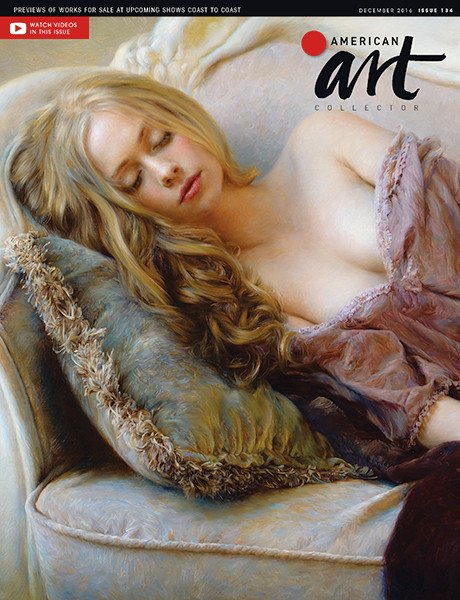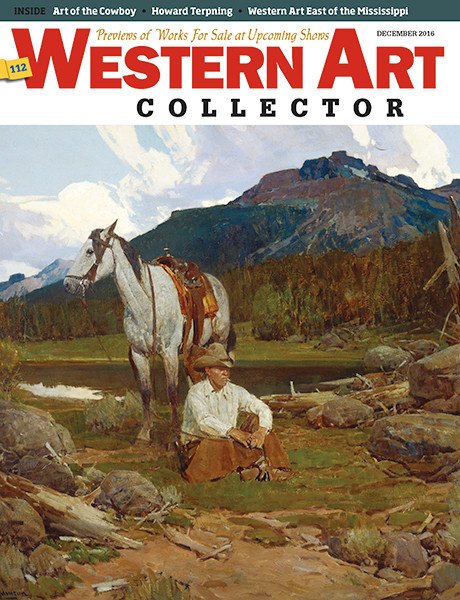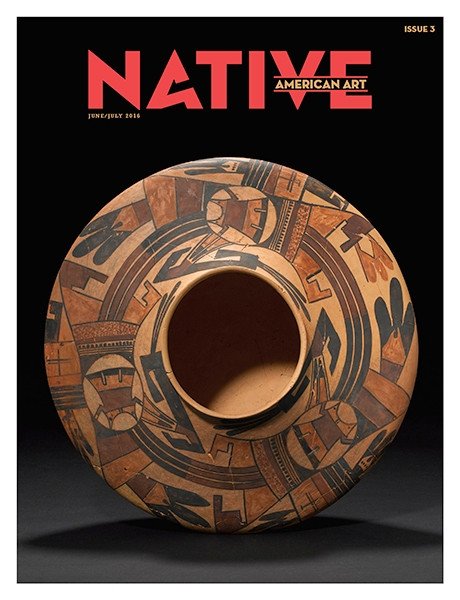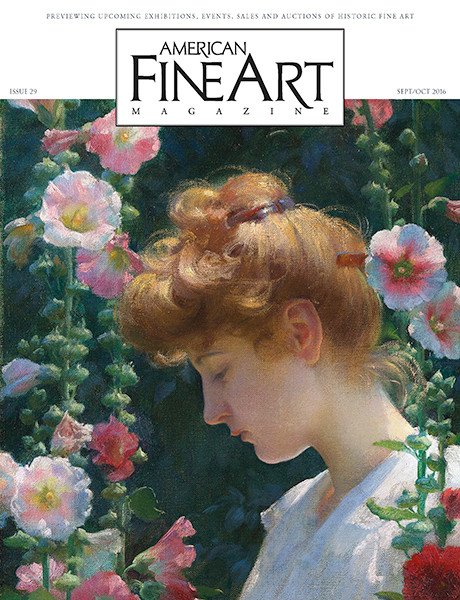 Rosie, Rosie, Lucy, Rose, oil, 18 x 24” (45 x 60 cm)
Rosie, Rosie, Lucy, Rose, oil, 18 x 24” (45 x 60 cm)
Grand Prize
Grand Prize is a four-page editorial feature in American Art Collector magazine
Matt Ryder
Dubai, United Arab Emirates
Painterly Petals
Artist Matt Ryder is no stranger to being featured in the pages of this magazine, and for good reason. The oil painter is a master of expressive brushstrokes, color and light, creating paintings that truly capture the many intricacies of nature’s blooms in a way that feels free-flowing.
“I aim for impressionistic realism, if that’s such a thing! I look to have the paintings read clearly from afar and when you get up close you can see abstract brushwork and flecks of color everywhere,” he says. “I focus on strong composition and simple subjects painted as beautifully as I can manage.”
His winning piece in this issue’s competition features an array of expressive roses in hues of pale pinks, whites and yellows.
“My inspiration comes from the beauty in the world around us, whether that’s flowers or landscape. I will always look for strong light (natural light being my favorite), strong composition and subjects that create some emotion in me. I don’t think I could ever run out of subjects to paint as long as I stick to this,” says Ryder.
Some of the most important elements for the artist, are constantly keeping color temperature and value at the front of his mind. “Both of these are so important when it comes to painting realism of any kind,” he says. In terms of technical application, Ryder finds it imperative to start thin and slowly build up texture once everything has been established, and in the right place compositionally.
“I feel like my work is in a constant state of development and evolution,” Ryder adds. “I’m always trying to come up with new ways to improve my technique and my approach to similar subjects. The main thing for me is to keep the enjoyment in creating, hopefully that comes through in my work.”
My Inspiration
When I visit rose gardens, I’m always looking for great light and interesting shapes that nature creates. So often it’s the negative space that I find inspiring, as was the case with this composition.
My Design Strategy
I wanted to create an interesting circular composition that will keep you moving around the painting. I did this by using areas of high contrast and complimentary color to act as a guide, allowing areas of rest by setting flowers deep into the background.
My Working Process
I put down an overall wash of Viridian and Transparent red oxide which I will allow to peek through in parts as the painting progresses. I then lift out areas of paint with paper towel to create the overall composition and build the flowers one at a time from there. I generally go from the centre of the flower and build out, with a strong emphasis on color temperature and value to bring life into them. I use the background to calve the shape of the flowers which gives me more freedom to play with my edges.
Contact Details
Email: info@ryderscanvas
Website: ryderscanvas.com
 THE SKY IS THE LIMIT, oil, 48 x 60” (121 x 152 cm)
THE SKY IS THE LIMIT, oil, 48 x 60” (121 x 152 cm)Second Prize
Second Prize is a two-page editorial feature in American Art Collector magazine
Francois Chartier
Quebec, Canada
My Inspiration
Everything around us is a source of inspiration. I don’t wait for inspiration, I like to manifest it myself by creating a situation that will trigger a random composition to work with. THE SKY IS THE LIMIT is a good example. By putting a flower in an aquarium with a piece of fabric floating behind it with bubbles all around, I knew I would have an amazing image. It’s now a matter of trial and error. It sometimes takes a few days and hundreds of photographs before I get the best composition. Very often the result is behind my expectation. When I have selected the final image, I’m now ready to paint.
My Design Strategy
As a hyperrealist, the first step is preparing the photo set up for the image I will use as my reference. Lighting is important: the bubbles, fabric and flower will be moving in water so I need a flash that will stop the movement. No matter what you do, lighting is what makes a picture. It will give the mood for the picture, no matter what your subject is.
My Working Process
I like to work on a smooth background so I will put a few coats of gesso on my canvas, then a medium color tone and print the subject to size, and then trace it with graphite carbon. I try to go as close to my final color with my first coat. In this case, after the first coat, I did a blue glazing over the fabric to get a more intense blue. After all is dry, I use a glossy varnish.
Contact Details
Email: francoischartier.art@gmail.com
Website: francoisc.com
 Pretty in Pink, oil, 30 x 30” (76 x 76 cm)
Pretty in Pink, oil, 30 x 30” (76 x 76 cm)Third Prize
Third Prize is a one-page editorial feature in American Art Collector magazine
Michele Van Maurik
Ontario, Canada
My Inspiration
My inspiration for Pretty in Pink came from my love of peonies; their very distinct fragrance and explosion of color, and petals remind me of childhood and a time of innocence. Growing up our neighbor had them in the front yard, and I associate the scent with warmer weather and the renewal of spring. This particular peony’s beautiful blush pink with its random accents of fuchsia and sunlit petals grabbed my attention and needed to be immortalized onto canvas.
My Design Strategy
In this painting, I had wanted to capture an up close and intimate detail of the peony, as though looking at it from the perspective of an insect. There are so many petals and detail that to include a background as well would compete with the flower and possibly have taken away from the bold and dramatic composition I was aiming for. In this case, I believed that less is more. With the elimination of the background, I chose a square format, which I felt would suit this painting best.
My Working Process
Creating a larger than life floral, full of detail, can take several weeks to complete. For this reason I require the addition of photographs as well as the actual flowers to paint from. Once I have my composition decided upon, I will usually draw my image on using a mid tone gray pastel pencil. At the start of my painting session, I invest some time determining which pigments will give me an accurate representation of what I am observing. This step is vital as it really saves me from having to repaint any areas where I have misjudged the hue or value. It is easy to get caught up in an area of detail and want to render it perfectly, however, I have learned over the years it is important to apply an entire layer of paint onto the canvas first; this will allow you to then accurately judge your values etc., and make any necessary adjustments at this point.
Contact Details
Email: mvanmaurik@aol.com
Website: michelevanmaurik.com
Finalists
Each receives an Award Certificate and a one-year subscription to International Artist magazine PLUS having their work seen worldwide by international galleries looking for new talent.
 Spring Song, watercolor, 14 x 21¼” (36 x 54 cm)
Spring Song, watercolor, 14 x 21¼” (36 x 54 cm)Jasmine Huang
New Taipei City, Taiwan
My Inspiration
I enjoy painting floral subjects because the rich colors of flowers always provide me with abundant creative inspiration. In September 2017, I visited the Louvre and took a walk in the nearby Tuileries Garden. The vibrant flowers lining the pathways caught my eye, particularly the blue sage, which stood out beautifully against the bright yellow background walls.
My Design Strategy
I started by dividing the scene into two major sections: the light yellow background and the green grass. Then, following the principle of “gathering and dispersing,” I placed the light violet-colored sage. Finally, I added a few spots of small orange flowers for decoration. The streamlined shapes of the flower stems help to organize the chaotic flower clusters and unify the overall composition.
My Working Process
My work process is similar to my design strategy: first, I brush out large areas of yellow and green, then add the colorful flowers. I frequently use the technique of “washing out and reapplying color,” which allows me to adjust the position and size of the flowers as needed for the overall structure. The stems and the flowers are done simultaneously, much like the lines and color blocks in abstract painting must be designed in tandem.
Contact Details
Email: colorok3h@gmail.com
Website: facebook.com/hsiaohui.huang.79
 Peonies and Champagne, oil, 30 x 30” (76 x 76 cm)
Peonies and Champagne, oil, 30 x 30” (76 x 76 cm)Nicole Finger
Colorado, USA
My Inspiration
Blossoming youth, life transition, ancient mountains and the fragrant breath of cut flowers all convey the ephemeral pull of time and a grasping at the fleeting nature and fragility of life. Profoundly humbled by such breathtaking landscapes in my own backyard in Telluride, Colorado, I never felt that duplicating them in paint at face value would do them justice. Instead, I found a contemporary twist of combining two disparate yet complementary subjects: short lived, delicate florals alongside the timeless permanence of our earth’s formations and landscapes. The custom of gifting and displaying flowers in celebration, memoriam and in appreciation of their inherent beauty amplifies the concept of timelessness versus inevitable loss and projects a plea to embrace the momentary with gratitude, respect and compassion.
My Design Strategy
I go through my collection of imagery trying to find the best match of landscape and florals in terms of mood, lighting and color, and then work them up slightly in Photoshop to find the best arrangement and composition.
My Working Process
I transfer the design to my canvas in a line drawing followed by a sepia wash underpainting. I then begin with full oil pigments and walnut alkyd medium. I generally work section by section in a direct painting process, frequently adding glazes once it dries. Especially with the white peonies, I brought up the glow by adding dry, rubbed glazes to the petals.
Contact Details
Email: nicole@fingerpaintingart.com
Website: fingerpaintingart.com
 Captured Heart, acrylic, 60 x 48” (152 x 121 cm)
Captured Heart, acrylic, 60 x 48” (152 x 121 cm)Susie McColgan
Michigan, USA
My Inspiration
I am inspired every day by the beauty of flowers. In Scotland, I was so inspired by the rhododendrons blooming they reminded me of a delicate love. Within this busy world, there is a place where soft, gentle love can be found. Like a secret, if we take the time to pause and look within...you will discover a delicate, treasured love to melt your heart.
My Design Strategy
I designed my composition to have all the high-intensity colors, sharp-edged and juxtaposed, motion infused geometric shapes circling around (and in contrast) to the soft and sheltered, calm cluster of blush colored blooms. By doing this, the viewer is drawn into the nucleus of the flowers feeling the peace and warmth of a gentle love, safe and sound while the outside fast-paced energy of the world carries on.
My Working Process
The first part of my process is creating my painting story. Sometimes it emerges while I’m taking photos of my subject, sometimes it evolves as I’m working. I like to do color thumbnails to experiment with design strategies to develop the story. I draw on the canvas in a “tattoo” style, which allows me to play with layers of translucent color washes creating a luminous glow while building rich, thick colors to strengthen color harmonies.
Contact Details
Email: susiemccolganart@gmail.com
Website: susiemccolgan.com
 Momentary Love, pastel, 18 x 12” (45 x 30 cm)
Momentary Love, pastel, 18 x 12” (45 x 30 cm)TaiMeng Lim
Selangor, Malaysia
My Inspiration
Epiphyllum is one of my favorite flowers for my still-life painting collection. Its delicate and elusive bloom only graces the night, withering away before the break of dawn. Over the years, I have been fortunate enough to have this plant in my gardens, allowing me to witness this mesmerizing process and truly appreciate the fleeting beauty of its blossoms. The way it transforms the darkness into a captivating work of art is truly remarkable. Moreover, due to its rarity, I often consider this flower as a symbol of good fortune for those fortunate enough to witness its blooming, embodying a deep sense of admiration.
My Design Strategy
The flowering period of Epiphyllum is brief but exquisite. To immortalize this fleeting moment, one can only seize it through the lens of a camera. By employing a delicate lighting arrangement, my intention was to intensify the painting’s ambiance, making it more vivid and enigmatic. Furthermore, I have meticulously rearranged the composition to achieve the optimal design for this artwork.
My Working Process
I used UART 500 sanded paper as the surface for my pastel artwork, allowing me to apply multiple layers. Beginning with a charcoal pencil sketch, I then applied a thin layer of burnt sienna transparent acrylic wash to fix the drawing. Employing both pastel pencils and sticks, my technique involved depicting the flower, leaves and background in a specific sequence, progressing from light to dark to prevent excessive pigment accumulation. The Terry Ludwig Intense Darks II series was predominantly used on the background to create depth and enhance the flower’s presence. Adjusting details and hues carefully, I aimed to achieve overall harmony and color balance in the painting.
Contact Details
Email: info@taimenglim.com
Website: taimenglim.com
 FLORAL FOR LOVEY, oil, 20 x 16” (50 x 40 cm)
FLORAL FOR LOVEY, oil, 20 x 16” (50 x 40 cm)Scott Royston
Maryland, USA
My Inspiration
Out of the many Old Masters I’ve learned from and works I’ve studied, my heart has always gone back to the 16th and 17th Century Dutch Masters. Among them, Jan Van Huysum stands out as a favorite. His rich translucency of the flowers lights up against the darker backdrops, whether it be as simple as a niche or as complicated as a spring park setting, a sense of metaphor shows the flowers having a shorter life versus the birds’ nests and insects having longer life. And how could one not stop and press their noses against these breathtaking pieces without inspecting how many dew drops are present? Although this was a commission, I was given free range which is always fun and exciting.
My Design Strategy
While doing any complicated piece takes hours in designing a composition, along with wiping out and redrawing, florals are no different in their challenge for what will work as the best composition from one piece to another. I needed to start off deciding what the overall design would be regarding how I wanted the viewer’s eye to follow, along with a backdrop. Once established, it was time to pick the flowers and placement, thinking about what has longer stalks than others, while putting complementary colors that go well together or contrasting colors that help to add depth and drama.
My Working Process
I start off with a loose sketch with a thin ivory or bristle filbert brush and Maroger medium, a mixture of half black oil and half mastic. Once my entire composition is mapped out, I can go into my subjects with graphic drawing with a rigger or long pointed sable brush, followed by an underpainting with a bristle brush. Once dried, I can start my next stage with establishing color with value and hues, while also using a bristle brush, which holds more paint to help apply a thicker first coat. Upon completing this sitting, it is important to knock down hard edges with a blending brush. When dry to the touch, I can now go into detail with a mongoose brush to tighten details and redefine drawing and accurate values. Details such as insects and dew drops bring the last chapter to a close.
Contact Details
Email: scottbroyston@yahoo.com
Website: scottroyston.com




